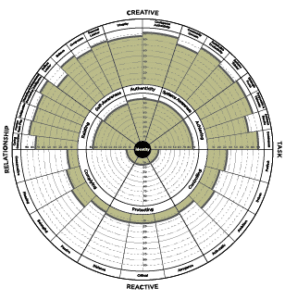A Universal Model of Leadership
Developing leaders for the complexity they face.
By Bob Anderson and Bill Adams
We must accelerate the pace at which we can develop leaders for the complex realities of today’s business environment. The pace of development must at a minimum keep pace with the rate of change and escalating complexity. This is the Leadership Agenda facing most organizations. Current approaches to developing leaders are not up to this challenge. The field of leadership development is a random collection for very good theory and research, but is completely unintegrated. This leads to a piecemeal approach that has a poor track record.
After 30 years of effort to integrate the fragmented field of leadership theory and research, we have developed a Universal Model of Leadership. It is a model that is both complex enough and elegant enough to take on the complex task of developing leaders for the future.

This four-quadrant grid underlies the Universal Model of Leadership. A leader can manage people Creatively in a way that engages, empowers, and brings out the best in them. Or, that leader can engage people Reactively in a way that may be people oriented and heart centered, but gives up too much power in service of being liked and accepted. A leader can manage tasks Creatively by being purpose driven and vision focused to achieve effective execution on results and systemic improvement. Or, a leader can manage tasks Reactively by over-controlling and driving the organization and people beyond sustainable limits.
From this core model, we have created the Leadership Circle Profile (LCP), a leadership 360 assessment designed to provide feedback to a leader on his/her effectiveness in relation to the Universal Model (see Figure 2). In the outer circle of the top half of the LCP is an array of 18 key Creative Leadership Competencies that are well research to correlate strongly to leadership effectiveness (r = .93) and business performance (r = .61). In the outer circ
The inner circle in the top half of the model groups the eighteen competencies into five categories that encompass the best leadership theory and research to emerge over the last century. These five categories are arranged along the Relationship-Task axis with Relating and Self-Awareness on the left or Relationship side of the circle and Achieving and Systems Awareness on the right or Task side. Authenticity is located in the center as it is central to establishing individual and collective leadership effectiveness.
The bottom half of the circle mirrors this arrangement. Complying is reactively people oriented and located on the lower-left below Relating. Controlling is on the lower-right below Achieving because Controlling is reactively task driven. Protecting is in the middle. This way of mapping the inner circle dimensions is the core of the model.
The Optimal Leadership Profile above was created by asking 50,000 managers worldwide to describe the kind of leadership that, if it existed in their organization, would allow the organization to thrive in its current marketplace and into the future. The resulting Optimal Leadership Profile has strong scores in the top half and low scores in the bottom half. The strength of a score in the LCP is displayed by its distance from the center. Strong scores, calculated as a percentile compared to our worldwide norm group, extend far out from center, while weak scores are closer to the center. Optimal leadership is highly Creative (at the 90th percentile compared to our worldwide norm base of how leaders are evaluated on the LCP) with low Reactive scores (at about the 10th percentile). It also has strong and balanced Task-Relationship capability. Different cultures describe a similar picture of optimal leadership.
Since effective leadership, individual and collective, contributes to business success, why do so few organizations have leadership cultures that reflect what we know works? Why do we not have better ways to measure and track the development of the individual and collective effectiveness of leadership? Why is this Leadership Agenda not a business imperative held by senior leaders as a strategic priority for creating competitive advantage?
Our research provides solid evidence that leadership capability and effectiveness are highly dependent upon the Stage of Development of the Leader, validating the primacy of the inner game on leadership effectiveness. Extraordinary capability emerges as the Creative Stage of Leadership matures.
Development is the dual helix combination of competency and consciousness, the inner game and the outer game, mastery and maturity. The Universal Model of Leadership integrates the best of theory and practice of developing leaders.
All of these findings suggest that the development of effective leadership, especially in complex leadership roles, is a long-term project—it is life work. The process of developing extraordinary leadership is the same process as becoming an extraordinary person. If we are to fulfill on the Leadership Agenda facing us, we need to rethink how we are developing leaders. Our efforts need to be long-term and systemic (not episodic and piecemeal), individual and collective, and integrative of the inner and outer game of leadership. Anything less is not likely to succeed.
The practice of developing extraordinary leaders, capable of elegantly and masterfully leading in today’s complex global business environment, must place equal emphasis on developing capability and consciousness. The inner game and the outer game must be co-developed. This is a leadership imperative. It is the development agenda, individually and collectively, for those in positions of leadership.
# # #
Excerpted from Mastering Leadership: An Integrated Framework for Breakthrough Performance and Extraordinary Business Results, by Robert J. Anderson and William A. Adams (Wiley, 2015)
Bob Anderson is Chairman and Chief Development Officer and Bill Adams is CEO of The Leadership Circle and the Full Circle Group. They are coauthors of Mastering Leadership (Wiley). Visit www.fcg-global.com or http://www.leadershipcircle.com.






Join the discussion One Comment